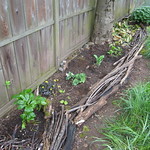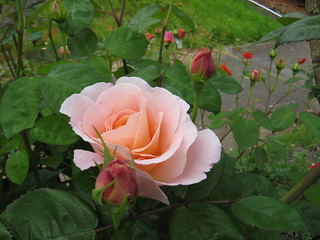Showing posts with label perennials. Show all posts
Showing posts with label perennials. Show all posts
09 June 2016
25 April 2015
04 April 2015
Mugwort
Usually the mugwort comes up, blooms, and begins to fade before I even realize it's there. But with the early warm weather this year, I'm out in the yard early. Early enough to see the magic mugwort.
30 September 2014
01 August 2014
15 July 2014
29 June 2014
07 July 2013
Blueberries, decaf
As is often recommended, I've been fertilizing my blueberry bushes with coffee grounds. Twice yearly, in early Spring and Fall, for about seven years. Wow. I just realized I planted those bushes seven years ago! Time, whoosh!
Last year I noticed the berries seemed to be getting more and more tart each year, losing not only sweetness but any true blueberry flavor. I decided to experiment with stopping the coffee grounds.
So, I skipped the coffee in Fall 2012 and Spring 2013. And, interestingly, the berries do seem sweeter this year. It's hard to say though because we've also had odd weather -- an excessively wet spring, followed by a sudden shift to unusually hot (90+) weather.
Is it lack of coffee, or the extra water followed by extra heat that caused the sweetness?
Can't say, but I think will continue the no coffee rule at least through the next growing season.
20 May 2013
10 October 2012
11 August 2012
30 April 2012
07 October 2009
Noxious Weed - Level B
As of December 31, 2009, butterfly bush are only allowed to be sold by a few licensed nurseries in Oregon. Existing plants, both at nurseries and in home gardens, must be dead-headed so they can't go to seed.
The Oregon Department of Agriculture has classified the butterfly bush as a Level B noxious weed because:
ODA Plant Division. Noxious Weed Control
The Oregon Department of Agriculture has classified the butterfly bush as a Level B noxious weed because:
"This plant is a pioneering species that dominates open habitats. It poses an ecological threat to dry-land meadows, open slopes and dunes, dominating these sites as much as Scotch broom has historically. It also invades reforested sites, resulting in a loss of forest productivity."Today I dead-headed the one butterfly bush I have on my sidewalk strip, placing the seed heads into my worm bin where they will be obliterated by hungry red wigglers.
ODA Plant Division. Noxious Weed Control
13 August 2009
Twice bloom lavender
All my Spanish lavenders are blooming again this week. Beautiful, but strange. I don't know if it's because I dead-headed them after the first bloom or if it's because of the record-breaking days 105+ heat in late-July. Either way. Lovely and fragrant.
I picked up a yellow lavender for the empty spot in my lavender walk, but no chance to plant it yet. Maybe this weekend, maybe...
26 April 2009
Sharing
One way to expand your garden on the cheap is to share and trade plants with friends and neighbors. Many plants spread and unless you have infinite room with perfect conditions, you'll have extra plants on your hands anyway.
Hostas are such a plant. Unless split vigorously, they will multiply in on themselves in an ultimately harmful way.

When the nubs first appear in March or April, you can divide the mass into smaller clumps and replant elsewhere. They survive the division very well.
Hostas are such a plant. Unless split vigorously, they will multiply in on themselves in an ultimately harmful way.
When the nubs first appear in March or April, you can divide the mass into smaller clumps and replant elsewhere. They survive the division very well.
17 March 2009
Mondo mondo mondo
Every Spring, Portland's Chinese Garden hosts a plant sale. It's a great opportunity to support the garden and obtain some neat plants for your garden. Plus, knowledgeable volunteers will be on hand to answer questions and offer advice.
I buy a black mondo every year. It spreads easily (but not invasive) and can be divided, so it's a good value if you have a little patience.

After careful selection of the best mondo, I stroll around the garden, always surprised at how much life is stirring so early in the season. Then tea and almond cookies at the onsite Tao of Tea. Nice.
I buy a black mondo every year. It spreads easily (but not invasive) and can be divided, so it's a good value if you have a little patience.

After careful selection of the best mondo, I stroll around the garden, always surprised at how much life is stirring so early in the season. Then tea and almond cookies at the onsite Tao of Tea. Nice.
04 March 2009
Lenten rose by any other name
Christmas Rose, Lenten Rose, Helleborus.... are all names for the genus Helleborus, which I first learned of from a Martha Stewart article, lo, many years ago, long enough ago that the common "white" was the only color mentioned, and the only color I saw in gardens for several years.
Hellebore (pl.) bloom very early and reach their zenith around the beginning of Lent. My own interest in hellebore admittedly increased when color variations began appearing in American nurseries. But, at $15-20 more than their plain relations, not many of the flashy hellebore have made it into my garden, except for the "Black Magic" pictured below.
In Timber Press's Hellebores: A Comprehensive Guide**, authors Burrell and Tyler note that aside from a handful found in Britain and one in China, "the rest of the species fall in between, with the bulk of them centered in the Balkan region of the former Yugoslavia." This excellent book may be available at your public library, or you can support my garden by purchasing the book through the Amazon widget (at right).
Because of our shared Balkan connection, I nicknamed the dark beauty above Helleborus mavrud after the blood red wine indigenous to Bulgaria. Cut, the flower-like stems last a very long time in fresh water.
** Book featured for purchase : see bottom of page
Hellebore (pl.) bloom very early and reach their zenith around the beginning of Lent. My own interest in hellebore admittedly increased when color variations began appearing in American nurseries. But, at $15-20 more than their plain relations, not many of the flashy hellebore have made it into my garden, except for the "Black Magic" pictured below.
In Timber Press's Hellebores: A Comprehensive Guide**, authors Burrell and Tyler note that aside from a handful found in Britain and one in China, "the rest of the species fall in between, with the bulk of them centered in the Balkan region of the former Yugoslavia." This excellent book may be available at your public library, or you can support my garden by purchasing the book through the Amazon widget (at right).
Because of our shared Balkan connection, I nicknamed the dark beauty above Helleborus mavrud after the blood red wine indigenous to Bulgaria. Cut, the flower-like stems last a very long time in fresh water.
** Book featured for purchase : see bottom of page
Subscribe to:
Posts (Atom)









